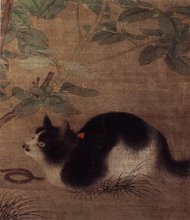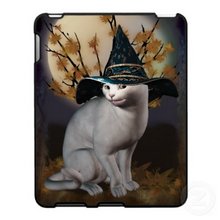Sacred Felines: History of the Cat Part 2

As you learned yesterday, cat history is a multifaceted and complicated subject. As far as science is concerned, the earliest sign of cat domestication began in ancient Greece with the advent of agricultural societies. Later in the history of the cat, ancient Egyptians began to worship them as gods, and for the first time in the history of the cat, felines got a taste of the royal treatment.
This history of the cat's worship began as a totemic practice, (the worship of an animal as a spiritual symbol) but was later further organized with the cat holding a legitimate spot in the Egyptian pantheon. There were three cat goddesses of note: Mafdet, Bast, and Sehkmet. Mafdet was the goddess of Justice. Bast began as a lion goddess but eventually became more cat-like as her role was marginalized. She was the protective patron deity of Lower Egypt, as well as a handmaiden and protector of the sun god, Ra. Sehkmet also began as a lioness, but ended up becoming more cat-like over time. She replaced Bast as the protector of Ra and the pharaohs.
Around the year390 BC the main cult in ancient Egypt that worshiped cats was disbanded, and kitties began to lose their significance, although their influence never completely fizzled out. Because of their awesome hunting skills, cats have always been valued residents of whatever culture and time period they happen to inhabit. Cat history is filled with owners thankful to be pest-free.
began to lose their significance, although their influence never completely fizzled out. Because of their awesome hunting skills, cats have always been valued residents of whatever culture and time period they happen to inhabit. Cat history is filled with owners thankful to be pest-free.
The history of the cat isn't limited to a single location though. They are valued companions all over the globe. During the Song Dynasty in China around a thousand years ago, cats were treated as the favored pets among nobility. They went so far as to advertise and sell fish exclusively for cat feeding in the ancient Chinese markets. In much of Europe and the United States, cats enjoyed a more infamous sort of notoriety. They became associated with witches as familiars and servants of the devil.
infamous sort of notoriety. They became associated with witches as familiars and servants of the devil.
This superstition persists in culture even today, as people will always assume a black cat crossing their path is an ill omen. Myths even include stories of cats sadistically smothering infant children by stealing all of the air from their noses. The crazy thing about that one is it may actually be rooted in reality. Cats have been known to lie on top of infant children for warmth, in some cases suffocating the child. However, in the United Kingdom it is considered good luck for a black cat to enter a home or climb aboard a ship. It seems human beings are often as ambivalent toward cats as they are towards us.
It’s plain to see that cat history is a rich and varied subject of study. Throughout these two blog posts we’ve hardly scratched the surface of the multitudes of stories and folklore surrounding our favorite felines. One thing is for certain; whether it’s bad press or preferential treatment, our complicated relationship with these cats isn’t ending anytime soon.
This history of the cat's worship began as a totemic practice, (the worship of an animal as a spiritual symbol) but was later further organized with the cat holding a legitimate spot in the Egyptian pantheon. There were three cat goddesses of note: Mafdet, Bast, and Sehkmet. Mafdet was the goddess of Justice. Bast began as a lion goddess but eventually became more cat-like as her role was marginalized. She was the protective patron deity of Lower Egypt, as well as a handmaiden and protector of the sun god, Ra. Sehkmet also began as a lioness, but ended up becoming more cat-like over time. She replaced Bast as the protector of Ra and the pharaohs.
Around the year390 BC the main cult in ancient Egypt that worshiped cats was disbanded, and kitties
 began to lose their significance, although their influence never completely fizzled out. Because of their awesome hunting skills, cats have always been valued residents of whatever culture and time period they happen to inhabit. Cat history is filled with owners thankful to be pest-free.
began to lose their significance, although their influence never completely fizzled out. Because of their awesome hunting skills, cats have always been valued residents of whatever culture and time period they happen to inhabit. Cat history is filled with owners thankful to be pest-free.The history of the cat isn't limited to a single location though. They are valued companions all over the globe. During the Song Dynasty in China around a thousand years ago, cats were treated as the favored pets among nobility. They went so far as to advertise and sell fish exclusively for cat feeding in the ancient Chinese markets. In much of Europe and the United States, cats enjoyed a more
 infamous sort of notoriety. They became associated with witches as familiars and servants of the devil.
infamous sort of notoriety. They became associated with witches as familiars and servants of the devil.This superstition persists in culture even today, as people will always assume a black cat crossing their path is an ill omen. Myths even include stories of cats sadistically smothering infant children by stealing all of the air from their noses. The crazy thing about that one is it may actually be rooted in reality. Cats have been known to lie on top of infant children for warmth, in some cases suffocating the child. However, in the United Kingdom it is considered good luck for a black cat to enter a home or climb aboard a ship. It seems human beings are often as ambivalent toward cats as they are towards us.
It’s plain to see that cat history is a rich and varied subject of study. Throughout these two blog posts we’ve hardly scratched the surface of the multitudes of stories and folklore surrounding our favorite felines. One thing is for certain; whether it’s bad press or preferential treatment, our complicated relationship with these cats isn’t ending anytime soon.




Comment(s)0